Rapid Microwave-Assisted Synthesis of CuSe Nanoparticles for High-Sensitivity Serotonin Biosensing in Serum
Abstract
1. Introduction
2. Experimental Section
2.1. Materials
2.2. Materials Characterization and Instrumentation
2.3. Microwave-Assisted Synthesis of CuSe Nanoparticles
2.4. Electrochemical Studies
3. Results and Discussion
4. Conclusions
Author Contributions
Funding
Institutional Review Board Statement
Informed Consent Statement
Data Availability Statement
Conflicts of Interest
References
- Lin, M.; Tsay, H.; Su, W.; Chueh, F. Changes in extracellular serotonin in rat hypothalamus affect thermoregulatory function. Am. J. Physiol. Regul. Integr. Comp. Physio. 1998, 274, R1260–R1267. [Google Scholar] [CrossRef] [PubMed]
- Lacasse, J.R.; Leo, J. Serotonin and depression: A disconnect between the advertisements and the scientific literature. PLoS Med. 2005, 2, e392. [Google Scholar] [CrossRef] [PubMed]
- Camilleri, M. Serotonin in the gastrointestinal tract. Curr. Opin. Endocrinol. Diabetes Obes. 2009, 16, 53–59. [Google Scholar] [CrossRef] [PubMed]
- Canli, T.; Lesch, K.-P. Long story short: The serotonin transporter in emotion regulation and social cognition. Nat. Neurosci. 2007, 10, 1103–1109. [Google Scholar] [CrossRef] [PubMed]
- Lee, D.K.; Markham, C.H.; Clark, W.G. Serotonin (5-HT) metabolism in Huntington’s chorea. Life Sci. 1968, 7, 707–712. [Google Scholar] [CrossRef]
- Bird, E.D. Chemical pathology of Huntington’s disease. Annu. Rev. Pharmacol. Toxicol. 1980, 20, 533–551. [Google Scholar] [CrossRef] [PubMed]
- Berger, M.; Gray, J.A.; Roth, B.L. The expanded biology of serotonin. Annu. Rev. Med. 2009, 60, 355–366. [Google Scholar] [CrossRef] [PubMed]
- Carver, C.S.; Johnson, S.L.; Joormann, J. Two-mode models of self-regulation as a tool for conceptualizing effects of the serotonin system in normal behavior and diverse disorders. Curr. Dir. Psychol. Sci. 2009, 18, 195–199. [Google Scholar] [CrossRef] [PubMed]
- Tekes, K. HPLC determination of serotonin and its metabolites from human platelet-rich plasma; shift to 5-hydroxytryptophol formation following alcohol consumption. J. Chromatogr. Sci. 2008, 46, 169–173. [Google Scholar] [CrossRef] [PubMed][Green Version]
- Maurer-Spurej, E.; Dyker, K.; Gahl, W.A.; Devine, D.V. A novel immunocytochemical assay for the detection of serotonin in platelets. Br. J. Haematol. 2002, 116, 604–611. [Google Scholar] [CrossRef] [PubMed]
- Khoshnevisan, K.; Maleki, H.; Honarvarfard, E.; Baharifar, H.; Gholami, M.; Faridbod, F.; Larijani, B.; Faridi Majidi, R.; Khorramizadeh, M.R. Nanomaterial based electrochemical sensing of the biomarker serotonin: A comprehensive review. Microchim. Acta 2019, 186, 49. [Google Scholar] [CrossRef] [PubMed]
- Abbaspour, A.; Noori, A. A cyclodextrin host–guest recognition approach to an electrochemical sensor for simultaneous quantification of serotonin and dopamine. Biosens. Bioelectron. 2011, 26, 4674–4680. [Google Scholar] [CrossRef] [PubMed]
- Xue, C.; Wang, X.; Zhu, W.; Han, Q.; Zhu, C.; Hong, J.; Zhou, X.; Jiang, H. Electrochemical serotonin sensing interface based on double-layered membrane of reduced graphene oxide/polyaniline nanocomposites and molecularly imprinted polymers embedded with gold nanoparticles. Sens. Actuators B Chem. 2014, 196, 57–63. [Google Scholar] [CrossRef]
- Tertiș, M.; Cernat, A.; Lacatiș, D.; Florea, A.; Bogdan, D.; Suciu, M.; Săndulescu, R.; Cristea, C. Highly selective electrochemical detection of serotonin on polypyrrole and gold nanoparticles-based 3D architecture. Electrochem. Commun. 2017, 75, 43–47. [Google Scholar] [CrossRef]
- Sharma, S.; Singh, N.; Tomar, V.; Chandra, R. A review on electrochemical detection of serotonin based on surface modified electrodes. Biosens. Bioelectron 2018, 107, 76–93. [Google Scholar] [CrossRef] [PubMed]
- Wei, N.; Zhao, X.-E.; Zhu, S.; He, Y.; Zheng, L.; Chen, G.; You, J.; Liu, S.; Liu, Z. Determination of dopamine, serotonin, biosynthesis precursors and metabolites in rat brain microdialysates by ultrasonic-assisted in situ derivatization–dispersive liquid–liquid microextraction coupled with UHPLC-MS/MS. Talanta 2016, 161, 253–264. [Google Scholar] [CrossRef] [PubMed]
- Kumar, S.; Darshan, S.; Baggi, T.R. Recent Advances in Analytical Techniques for Antidepressants Determination in Complex Biological Matrices: A Review. Int. J. Toxicol. 2023, 42, 352–364. [Google Scholar] [CrossRef] [PubMed]
- Dunham, K.E.; Venton, B.J. Improving serotonin fast-scan cyclic voltammetry detection: New waveforms to reduce electrode fouling. Analyst 2020, 145, 7437–7446. [Google Scholar] [CrossRef] [PubMed]
- Malik, S.; Singh, J.; Saini, K.; Chaudhary, V.; Umar, A.; Ibrahim, A.A.; Akbar, S.; Baskoutas, S. Paper-based sensors: Affordable, versatile, and emerging analyte detection platforms. Anal. Methods 2024, 16, 2777–2809. [Google Scholar] [CrossRef] [PubMed]
- Zhao, S.; Piatkevich, K.D. Techniques for in vivo serotonin detection in the brain: State of the art. J. Neurochem 2023, 166, 453–480. [Google Scholar] [CrossRef] [PubMed]
- Singh, R.; Gupta, R.; Bansal, D.; Bhateria, R.; Sharma, M. A Review on Recent Trends and Future Developments in Electrochemical Sensing. ACS Omega 2024, 9, 7336–7356. [Google Scholar] [CrossRef] [PubMed]
- Zhu, C.; Yang, G.; Li, H.; Du, D.; Lin, Y. Electrochemical Sensors and Biosensors Based on Nanomaterials and Nanostructures. Anal. Chem. 2015, 87, 230–249. [Google Scholar] [CrossRef] [PubMed]
- Shen, Y.; Zhao, S.; Chen, F.; Lv, Y.; Fu, L. Enhancing Sensitivity and Selectivity: Current Trends in Electrochemical Immunosensors for Organophosphate Analysis. Biosensors 2024, 14, 496. [Google Scholar] [CrossRef] [PubMed]
- Guo, L.; Zhao, Y.; Huang, Q.; Huang, J.; Tao, Y.; Chen, J.; Li, H.-Y.; Liu, H. Electrochemical protein biosensors for disease marker detection: Progress and opportunities. Microsyst. Nanoeng. 2024, 10, 65. [Google Scholar] [CrossRef] [PubMed]
- Sharma, P.; Bhalla, V.; Dravid, V.; Shekhawat, G.; Prasad, E.S.; Suri, C.R. Enhancing electrochemical detection on graphene oxide-CNT nanostructured electrodes using magneto-nanobioprobes. Sci. Rep. 2012, 2, 877. [Google Scholar] [CrossRef] [PubMed]
- He, L.; Cui, B.; Liu, J.; Song, Y.; Wang, M.; Peng, D.; Zhang, Z. Novel electrochemical biosensor based on core-shell nanostructured composite of hollow carbon spheres and polyaniline for sensitively detecting malathion. Sens. Actuators B Chem. 2018, 258, 813–821. [Google Scholar] [CrossRef]
- Dăscălescu, D.; Apetrei, C. Development of a novel electrochemical biosensor based on organized mesoporous carbon and laccase for the detection of serotonin in food supplements. Chemosensors 2022, 10, 365. [Google Scholar] [CrossRef]
- Sekar, S.; Yun, J.-S.; Lee, S. Metal-free electrocatalytic nanocomposites of poly azovan blue-decorated graphitic carbon nitride for simultaneously sensing paracetamol and 4-aminophenol. Environ. Res. 2023, 239, 117293. [Google Scholar] [CrossRef] [PubMed]
- Liuzhu, Z.; Sekar, S.; Chen, J.; Lee, S.; Kim, D.Y.; Manikandan, R. A polyrutin/AgNPs coated GCE for simultaneous anodic stripping voltammetric determination of Pb(II) and Cd(II)ions in environmental samples. Colloids Surf. A Physicochem. Eng. Asp. 2022, 648, 129082. [Google Scholar] [CrossRef]
- Devi, N.R.; Sasidharan, M.; Sundramoorthy, A.K. Gold nanoparticles-thiol-functionalized reduced graphene oxide coated electrochemical sensor system for selective detection of mercury ion. J. Electrochem. Soc. 2018, 165, B3046–B3053. [Google Scholar] [CrossRef]
- Wang, F.; Hu, S. Electrochemical sensors based on metal and semiconductor nanoparticles. Microchim. Acta 2009, 165, 1–22. [Google Scholar] [CrossRef]
- Huang, Q.; Lin, X.; Lin, C.; Zhang, Y.; Hu, S.; Wei, C. A high performance electrochemical biosensor based on Cu2O–carbon dots for selective and sensitive determination of dopamine in human serum. Rsc. Adv. 2015, 5, 54102–54108. [Google Scholar] [CrossRef]
- Chae, S.; Woo, C.; Gu, G.H.; Kim, T.Y.; Jeon, J.; Kwon, H.J.; Oh, S.; Choi, K.H.; Dong, X.; Ahn, J. Vanadium Selenide Nanobelt Electrocatalyst for Dopamine-Selective Detection. ACS Appl. Nano Mater. 2023, 6, 16242–16252. [Google Scholar] [CrossRef]
- Dăscălescu, D.; Apetrei, C. Nanomaterials based electrochemical sensors for serotonin detection: A review. Chemosensors 2021, 9, 14. [Google Scholar] [CrossRef]
- Sekar, S.; Huijun, J.; Liuzhu, Z.; Jin, C.; Lee, S.; Kim, D.Y.; Manikandan, R. Copper phthalocyanine conjugated graphitic carbon nitride nanosheets as an efficient electrocatalyst for simultaneous detection of natural antioxidants. Electrochim. Acta 2022, 413, 140150. [Google Scholar] [CrossRef]
- Chaudhary, C.; Kumar, S.; Chandra, R. Monophasic molybdenum selenide-reduced graphene oxide nanocomposite sheets based immunosensing platform for ultrasensitive serotonin detection. Microchem. J. 2020, 159, 105344. [Google Scholar] [CrossRef]
- Selvam, S.P.; Yun, K. A self-assembled silver chalcogenide electrochemical sensor based on rGO-Ag2Se for highly selective detection of serotonin. Sens. Actuators B Chem. 2020, 302, 127161. [Google Scholar] [CrossRef]
- Umapathi, S.; Masud, J.; Coleman, H.; Nath, M. Electrochemical sensor based on CuSe for determination of dopamine. Microchim. Acta 2020, 187, 440. [Google Scholar] [CrossRef] [PubMed]
- Murtada, K.; Salghi, R.; Ríos, A.; Zougagh, M. A sensitive electrochemical sensor based on aluminium doped copper selenide nanoparticles-modified screen printed carbon electrode for determination of L-tyrosine in pharmaceutical samples. J. Electroanal. Chem. 2020, 874, 114466. [Google Scholar] [CrossRef]
- Umapathi, S.; Singh, H.; Masud, J.; Nath, M. Nanostructured copper selenide as an ultrasensitive and selective non-enzymatic glucose sensor. Mater. Adv. 2021, 2, 927–932. [Google Scholar] [CrossRef]
- Yaseen, J.; Saira, F.; Imran, M.; Fatima, M.; Ahmed, H.E.; Manzoor, M.Z.; Rasheed, M.; Nisa, I.; Mehmood, K.; Batool, Z. Synthesis of CuSe/PVP/GO and CuSe/MWCNTs for their applications as nonenzymatic electrochemical glucose biosensors. RSC Adv. 2024, 14, 6896–6905. [Google Scholar] [CrossRef] [PubMed]
- Manikandan, R.; Kim, M.-J.; Jang, H.-G.; Mugunthan, A.; Kim, C.-S.; Yoon, J.-H.; Lee, J.; Chung, K.W.; Chang, S.-C. Fabrication of bio-mimic nanozyme based on Mxene@AuNPs and molecular imprinted poly(thionine) films for creatinine detection. Biosens. Bioelectron. 2025, 271, 117075. [Google Scholar] [CrossRef] [PubMed]
- Yang, S.; Ji, F.; Wang, Z.; Zhu, Y.; Hu, K.; Ouyang, Y.; Wang, R.; Ma, X.; Cao, C. Microwave-assisted synthesis of CuSe nano-particles as a high -performance cathode for rechargeable magnesium batteries. Electrochim. Acta 2019, 324, 134864. [Google Scholar] [CrossRef]
- Ghobadi, N.; Zamani Meymian, M.-R.; Fallah, M. Exploring secondary optical transitions: A study utilizing the DITM method, and enhanced photocatalytic properties in Ni-doped CuSe. Sci. Rep. 2024, 14, 7754. [Google Scholar] [CrossRef] [PubMed]
- Kim, C.R.; Yeol, H.S.; Hung, C.C.; Jin, L.T.; Ryu, S.O. A Study on Copper Selenide Thin Films for Photovoltaics by a Continuous Flow Microreactor. Mol. Cryst. Liq. Cryst. 2010, 532, 39/[455]–447/[463]. [Google Scholar] [CrossRef]
- Shitu, I.G.; Talib, Z.A.; Chi, J.L.Y.; Kechick, M.M.A.; Baqiah, H. Influence of tartaric acid concentration on structural and optical properties of CuSe nanoparticles synthesized via microwave assisted method. Results Phys. 2020, 17, 103041. [Google Scholar] [CrossRef]
- Rasheed, M.; Saira, F.; Batool, Z.; Khan, H.M.; Yaseen, J.; Arshad, M.; Kalsoom, A.; Ahmed, H.E.; Ashiq, M.N. Facile synthesis of a CuSe/PVP nanocomposite for ultrasensitive non-enzymatic glucose biosensing. RSC Adv. 2023, 13, 26755–26765. [Google Scholar] [CrossRef] [PubMed]
- Manikandan, R.; Kim, J.; Ishigami, A.; Cho, J.Y.; Kim, J.H.; Han, J.T.; Lee, J.; Chang, S.-C. Dispersant-free supra single-walled carbon nanotubes for simultaneous and highly sensitive biomolecule sensing in ex vivo mouse tissues. Carbon 2023, 213, 118275. [Google Scholar] [CrossRef]
- Manikandan, R.; Pugal Mani, S.; Selvan, K.S.; Yoon, J.-H.; Chang, S.-C. Fabrication of S and O-incorporated graphitic carbon nitride linked poly(1,3,4-thiadiazole-2,5-dithiol) film for selective sensing of Hg2+ ions in water, fish, and crab samples. Food Chem. 2023, 425, 136483. [Google Scholar] [CrossRef] [PubMed]
- Manikandan, R.; Pugal Mani, S.; Sangeetha Selvan, K.; Yoon, J.-H.; Chang, S.-C. Anodized screen-printed electrode modified with poly(5-amino-4H-1,2,4-triazole-3-thiol) film for ultrasensitive detection of Hg2+ in fish samples. J. Electroanal. Chem. 2023, 929, 117121. [Google Scholar] [CrossRef]
- Ilanchezhiyan, P.; Manikandan, R.; Sekar, S.; Jin Lee, D.; Chang Jeon, H.; Lee, S.; Chang, S.-C.; Young Kim, D. Two dimensional FeVO4 nanoflakes decorated on Ti3C2 MXene hybrid nanocomposites as a novel effective electrochemical biosensor for ultrasensitive and selective detection of serotonin (5-HT). Appl. Surf. Sci. 2025, 680, 161411. [Google Scholar] [CrossRef]
- Manikandan, R.; Jang, H.-G.; Kim, C.-S.; Yoon, J.-H.; Lee, J.; Paik, H.-j.; Chang, S.-C. Nano-engineered paper-based electrochemical biosensors: Versatile diagnostic tools for biomarker detection. Coord. Chem. Rev. 2025, 523, 216261. [Google Scholar] [CrossRef]
- Wu, B.; Yeasmin, S.; Liu, Y.; Cheng, L.-J. Sensitive and selective electrochemical sensor for serotonin detection based on ferrocene-gold nanoparticles decorated multiwall carbon nanotubes. Sens. Actuators B Chem. 2022, 354, 131216. [Google Scholar] [CrossRef]
- Musuvadhi Babulal, S.; Wu, H.-F.; Chien Wu, C. Two-Dimensional Phosphorus-Doped Tungsten Trioxide Nanosheets for Electrochemical Detection of Serotonin in Biological Fluids. ACS Appl. Nano Mater. 2023, 6, 14552–14562. [Google Scholar] [CrossRef]
- Mufeeda, M.; Ankitha, M.; Rasheed, P.A. Nb2CTx/Protonated Carbon Nitride Nanocomposite for Electrochemical Detection of Serotonin. ACS Appl. Nano Mater. 2023, 6, 21152–21161. [Google Scholar] [CrossRef]
- Xu, Q.-Q.; Luo, L.; Liu, Z.-G.; Guo, Z.; Huang, X.-J. Highly sensitive and selective serotonin (5-HT) electrochemical sensor based on ultrafine Fe3O4 nanoparticles anchored on carbon spheres. Biosens Bioelectron 2023, 222, 114990. [Google Scholar] [CrossRef] [PubMed]
- Han, J.; Stine, J.M.; Chapin, A.A.; Ghodssi, R. A portable electrochemical sensing platform for serotonin detection based on surface-modified carbon fiber microelectrodes. Anal. Methods. 2023, 15, 1096–1104. [Google Scholar] [CrossRef] [PubMed]
- Nayak, S.P.; Prathyusha, V.; Kumar, J.K.K. Eco-friendly surface modification of oxidized carbon nanotubes with curcumin for simultaneous electrochemical detection of dopamine and serotonin. Mater. Chem. Phys. 2022, 287, 126293. [Google Scholar] [CrossRef]
- Motsaathebe, P.C.; Fayemi, O.E. Serotonin electrochemical detection in tomatoes at MWCNT-AONP nanocomposite modified electrode. Mater. Res. Express. 2021, 8, 115004. [Google Scholar] [CrossRef]
- Masud, J.; Ioannou, P.-C.; Levesanos, N.; Kyritsis, P.; Nath, M. A Molecular Ni-complex Containing Tetrahedral Nickel Selenide Core as Highly Efficient Electrocatalyst for Water Oxidation. ChemSusChem 2016, 9, 3128–3132. [Google Scholar] [CrossRef] [PubMed]
- De Silva, U.; Masud, J.; Zhang, N.; Hong, Y.; Liyanage, W.P.R.; Asle Zaeem, M.; Nath, M. Nickel telluride as a bifunctional electrocatalyst for efficient water splitting in alkaline medium. J. Mater. Chem. A. 2018, 6, 7608–7622. [Google Scholar] [CrossRef]

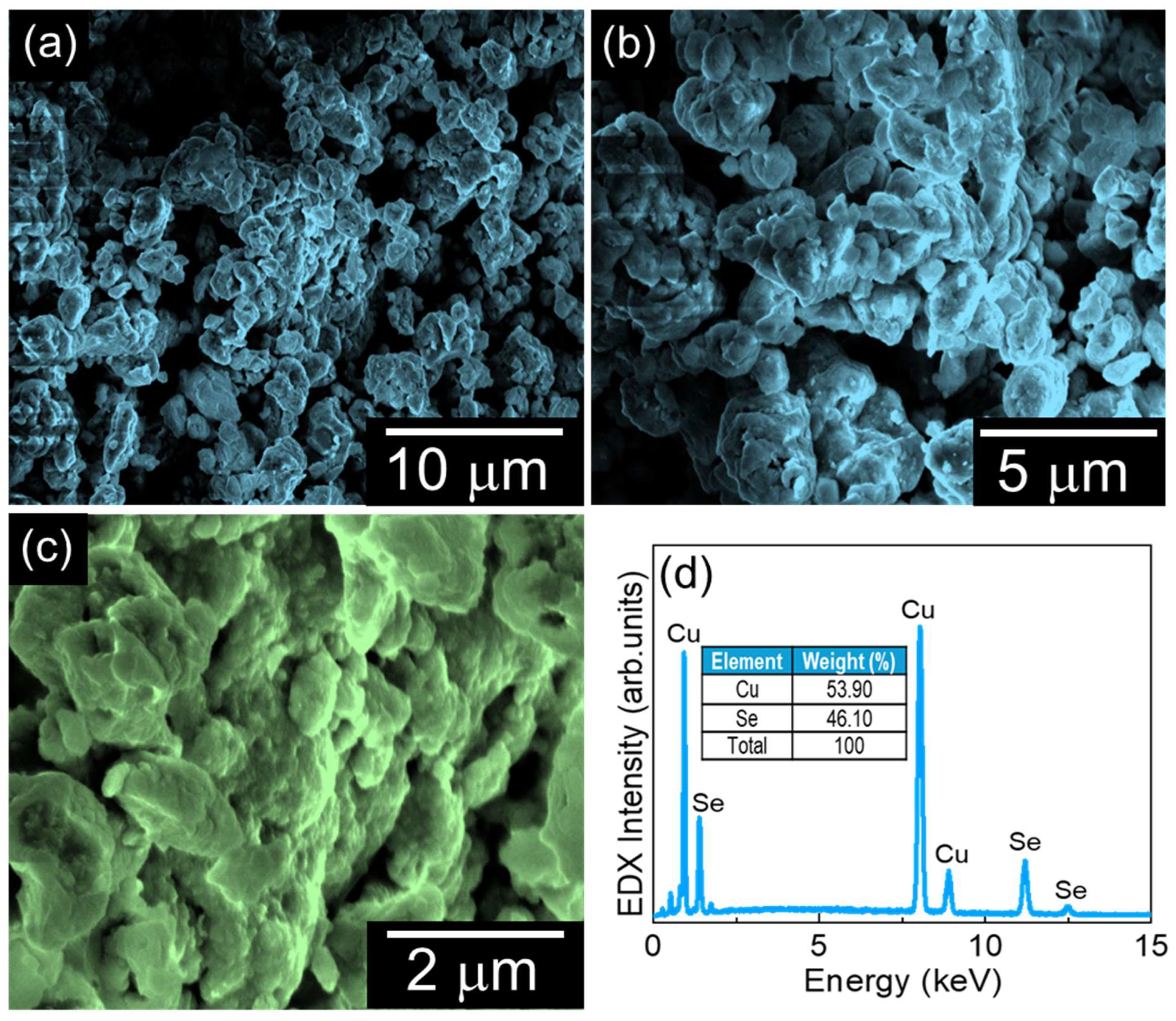
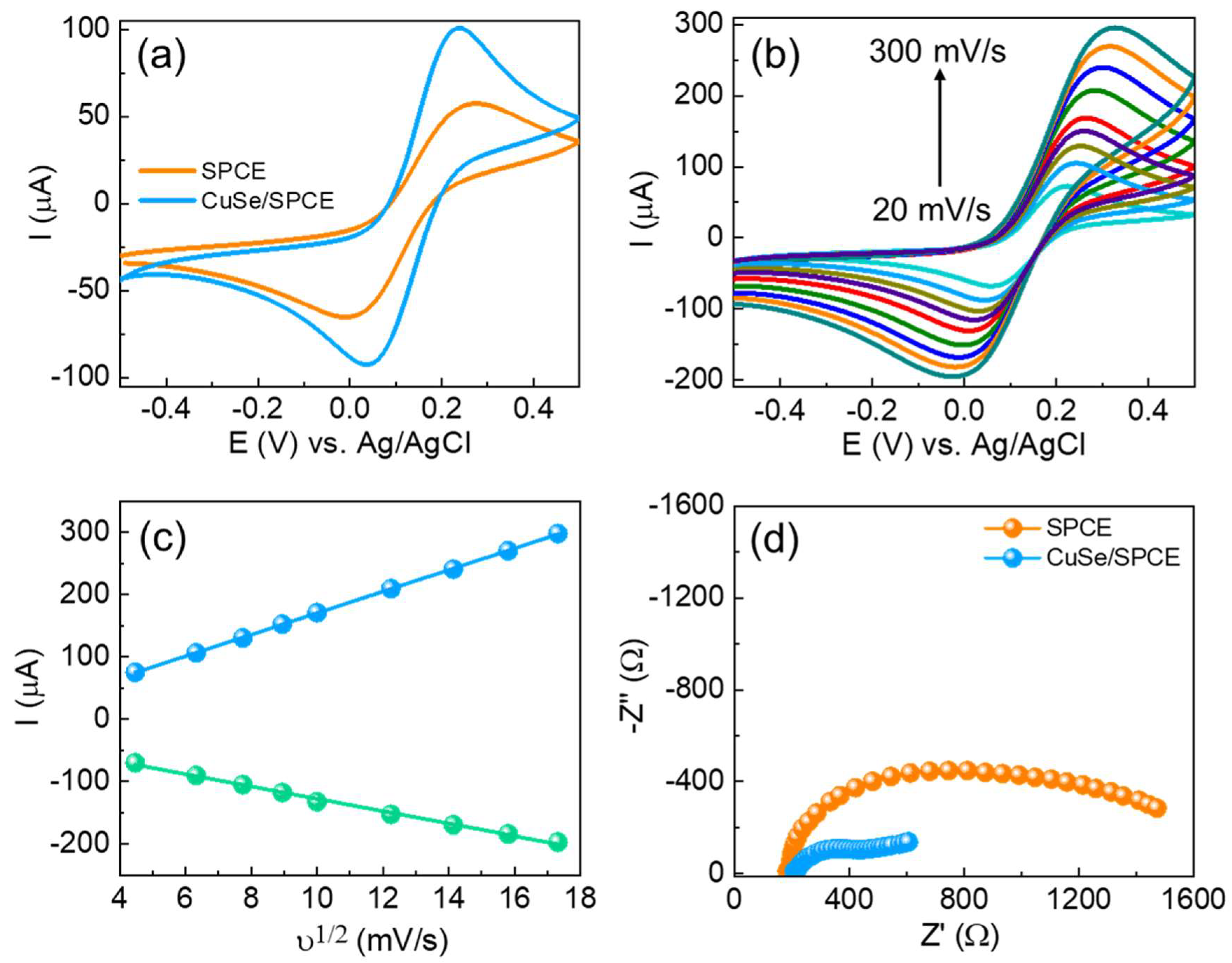
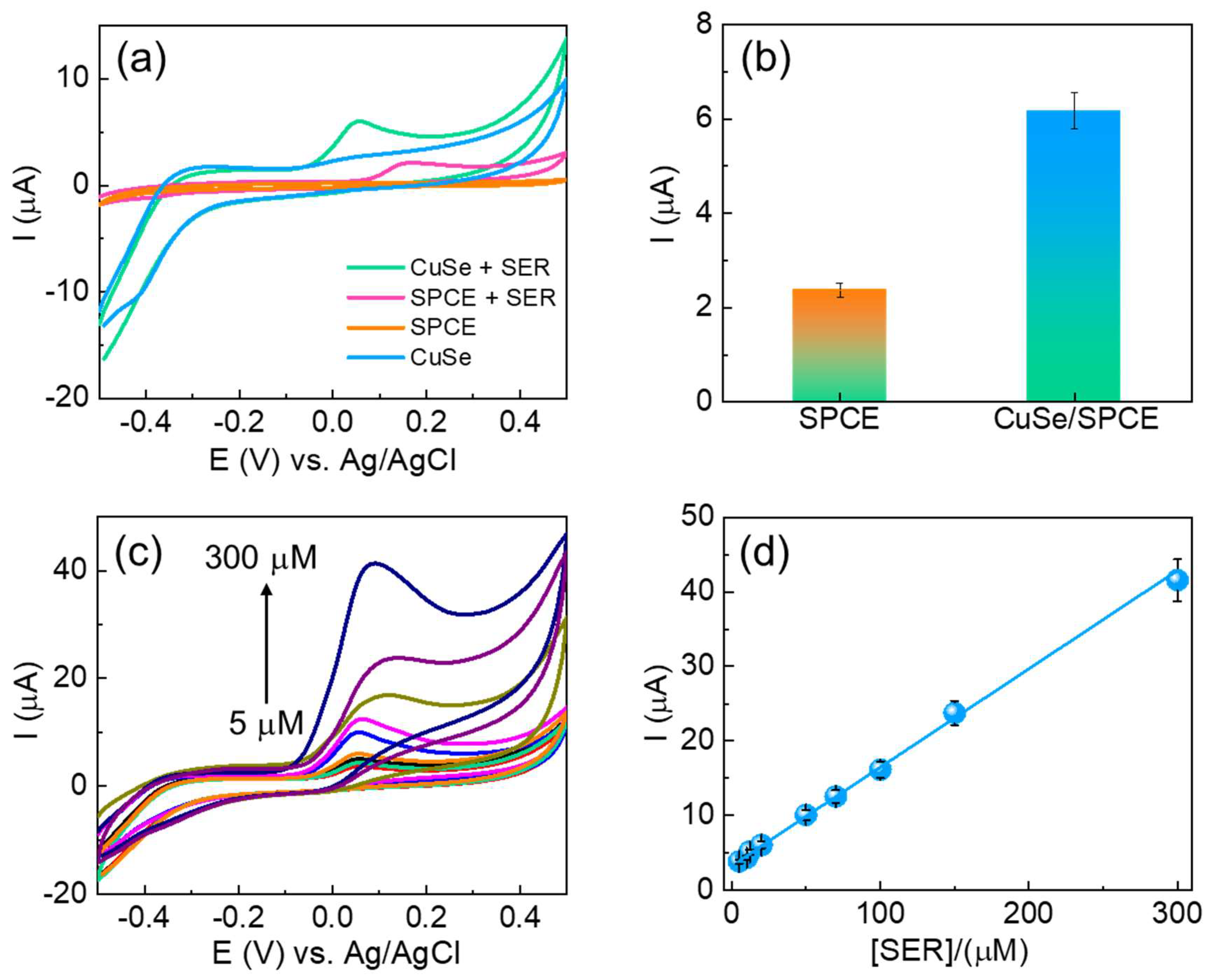
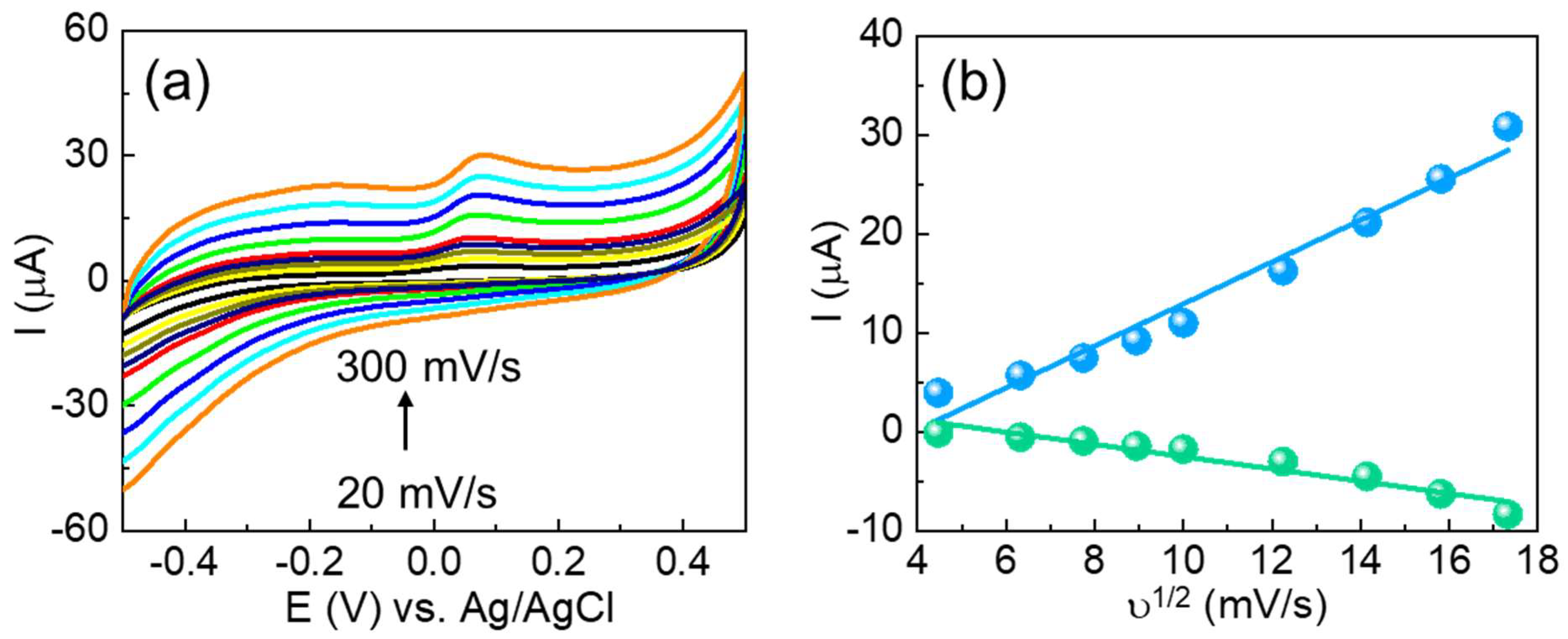
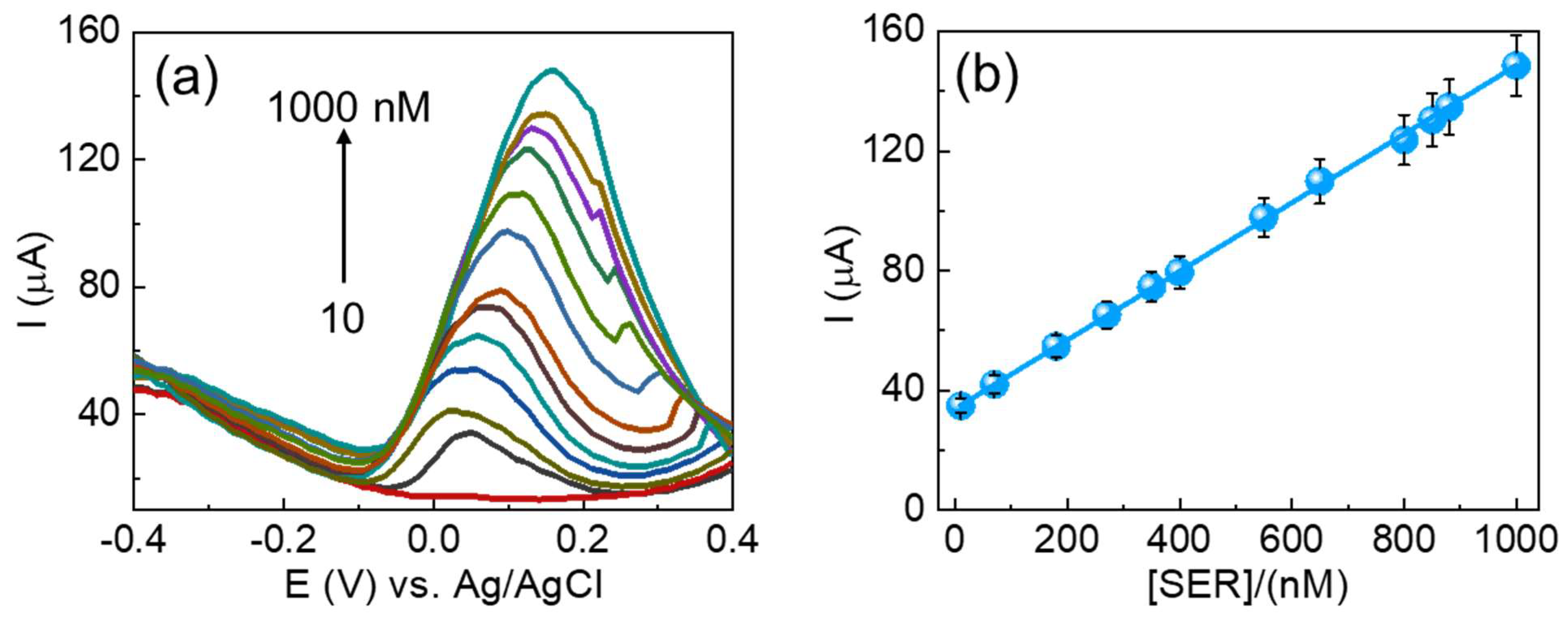
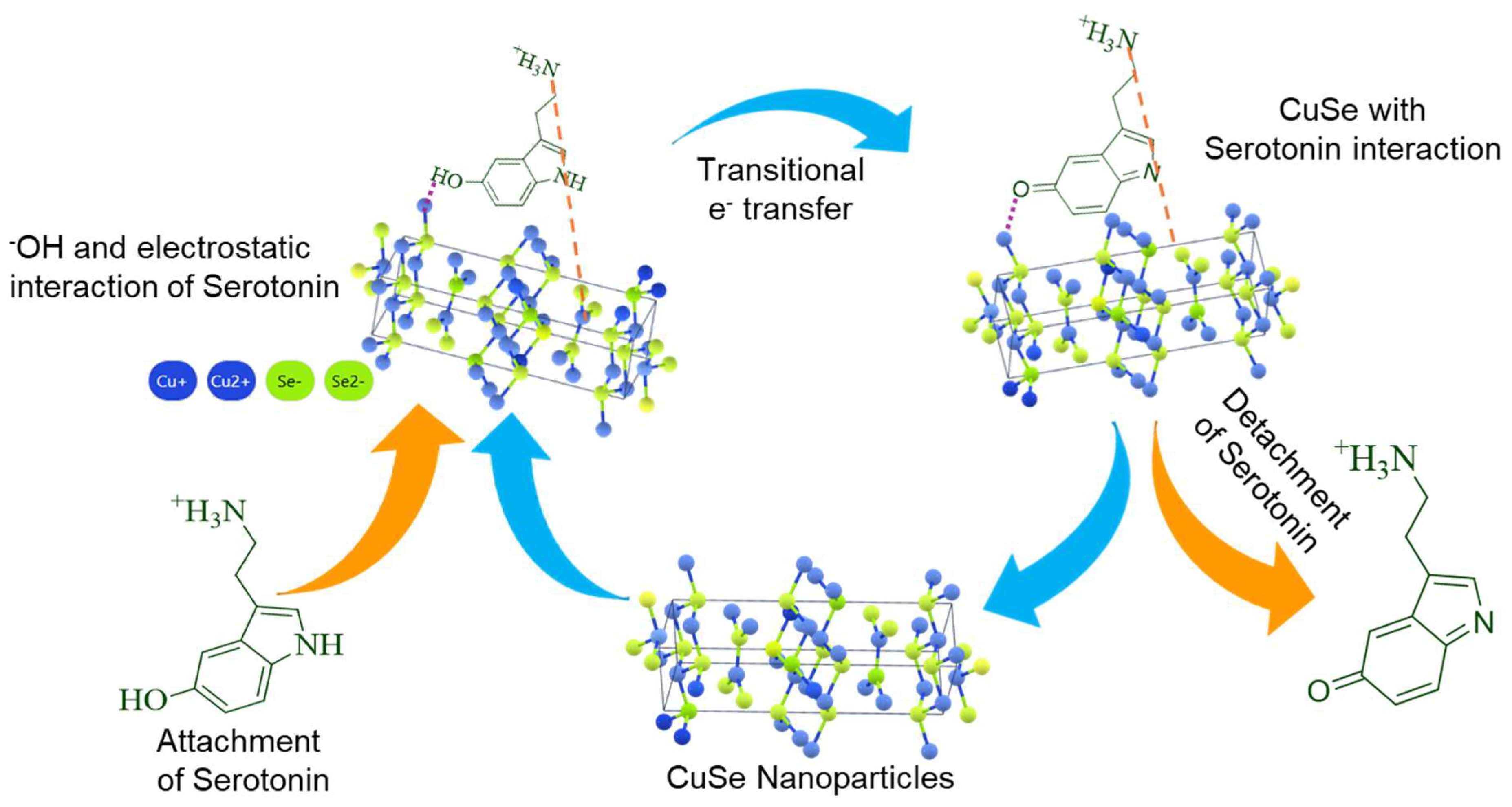

| Electrodes | Technique | Synthesis Approach | Range (nM) | Sensitivity (μA/µΜ cm−2) | LOD (nM) | Ref. |
|---|---|---|---|---|---|---|
| CuSe/SPCE | DPV | Microwave | 10–1000 | 12.45 | 3 | This work |
| Fc-AuNPs-MWCNT/SPCE | SWV | Chemical | 50–2000 | - | 17 | [53] |
| P-WO3NS/GCE | LSV | Hydrothermal | 10–10,000 | 0.2 | 60 | [54] |
| Nb2CTx/PCN/CCT | DPV | Chemical | 1000–10,000 | - | 63.24 | [55] |
| Fe3O4/CSs/GCE | DPV | Hydrothermal | 200–25,000 | 5.503 | 4 | [56] |
| Nafion-CNT/ECCFMEs | CV | - | 100–1000 | 0.074 | 140 | [57] |
| CM-oCNT/GCE | LSV | Electrodeposition | 10,000–170,000 | - | 11,000 | [58] |
| OMC-SPE/Lac | SWV | Chemical | 100–1200 | - | 316 | [27] |
| FVMX@SPCE | DPV | Chemical | 25–750 | 3.0 | 5.88 | [51] |
| MWCNT-AONP/SPCE | SWV | Chemical | 16–166 | - | 25 | [59] |
| Real Sample | Added (nM) | Found (nM) * | Recovery (%) | RSD (%) |
|---|---|---|---|---|
| Serum | 0 | 19 ± 0.05 | - | 1.12 |
| 30 | 29.06 ± 0.08 | 96.86 | 2.48 | |
| 50 | 51.07 ± 0.24 | 102.14 | 1.79 |
Disclaimer/Publisher’s Note: The statements, opinions and data contained in all publications are solely those of the individual author(s) and contributor(s) and not of MDPI and/or the editor(s). MDPI and/or the editor(s) disclaim responsibility for any injury to people or property resulting from any ideas, methods, instructions or products referred to in the content. |
© 2025 by the authors. Licensee MDPI, Basel, Switzerland. This article is an open access article distributed under the terms and conditions of the Creative Commons Attribution (CC BY) license (https://creativecommons.org/licenses/by/4.0/).
Share and Cite
Sekar, S.; Manikandan, R.; Arumugasamy, S.K.; Sekar, S.; Lee, Y.; Chang, S.-C.; Lee, S. Rapid Microwave-Assisted Synthesis of CuSe Nanoparticles for High-Sensitivity Serotonin Biosensing in Serum. Chemosensors 2025, 13, 264. https://doi.org/10.3390/chemosensors13070264
Sekar S, Manikandan R, Arumugasamy SK, Sekar S, Lee Y, Chang S-C, Lee S. Rapid Microwave-Assisted Synthesis of CuSe Nanoparticles for High-Sensitivity Serotonin Biosensing in Serum. Chemosensors. 2025; 13(7):264. https://doi.org/10.3390/chemosensors13070264
Chicago/Turabian StyleSekar, Sankar, Ramalingam Manikandan, Shiva Kumar Arumugasamy, Saravanan Sekar, Youngmin Lee, Seung-Cheol Chang, and Sejoon Lee. 2025. "Rapid Microwave-Assisted Synthesis of CuSe Nanoparticles for High-Sensitivity Serotonin Biosensing in Serum" Chemosensors 13, no. 7: 264. https://doi.org/10.3390/chemosensors13070264
APA StyleSekar, S., Manikandan, R., Arumugasamy, S. K., Sekar, S., Lee, Y., Chang, S.-C., & Lee, S. (2025). Rapid Microwave-Assisted Synthesis of CuSe Nanoparticles for High-Sensitivity Serotonin Biosensing in Serum. Chemosensors, 13(7), 264. https://doi.org/10.3390/chemosensors13070264






